November 27, 2025 | 21:07 GMT +7
November 27, 2025 | 21:07 GMT +7
Hotline: 0913.378.918
November 27, 2025 | 21:07 GMT +7
Hotline: 0913.378.918
According to a large enterprise owner with many years of experience in rice export, every year during the rice harvest, functional sectors, localities and enterprises would always meet to discuss solutions, but the rice industry still faced ample difficulties.
“Farmers selling fresh rice in the field are easily forced to lower prices. Traders are also a factor of uncertainty, sometimes they forfeit deposits or cancel contracts to reduce losses. The chain has not completely solved the price problem, because during the main crop season, the pressure to consume products from 1.5 million ha of rice is immense. Even businesses with warehouses and capital do not dare to stockpile too much due to market risks and high interest rates,” he said.
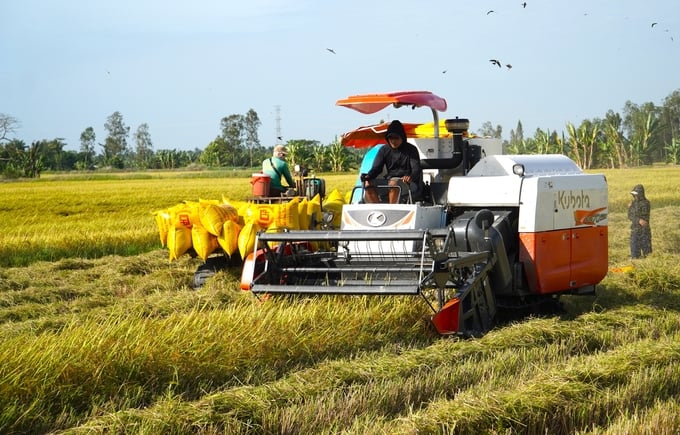
Rice consumption in the Mekong Delta often faces difficulties during the main crop season specifically the winter-spring crop. Photo: Kim Anh.
Regarding this issue, at the Conference on Rice Production and Consumption in the Mekong Delta recently chaired by Minister of Agriculture and Environment Do Duc Duy, Truong Manh Linh, CEO of Tan Long Group said, “Tan Long Group is piloting a model where farmers and cooperatives can send rice to the factory for processing and long-term storage (for a fee). This model helps farmers have more options for storing rice, making the purchasing and consumption process transparent.”
Tan Long Group has a warehouse system to store 300,000 tons of rice. Hanh Phuc Rice Factory in Tri Ton district, An Giang province in particular has the capacity to store 120,000 tons.
Kien Giang currently possesses the largest rice growing area in the Mekong Delta region, so the sustainable development of the rice industry plays an important role in the province. Kien Giang has 60,000 ha of rice produced to meet orders from 21 enterprises, mainly Tan Long Group, Trung An High-Tech Agriculture Joint Stock Company, Loc Troi Group, and many more. It is expected that approximately 70% of Kien Giang’s rice area will be proactive in terms of linkage if this province expands the growing area under the Scheme of 1 million ha of high-quality rice to 100,000 ha.
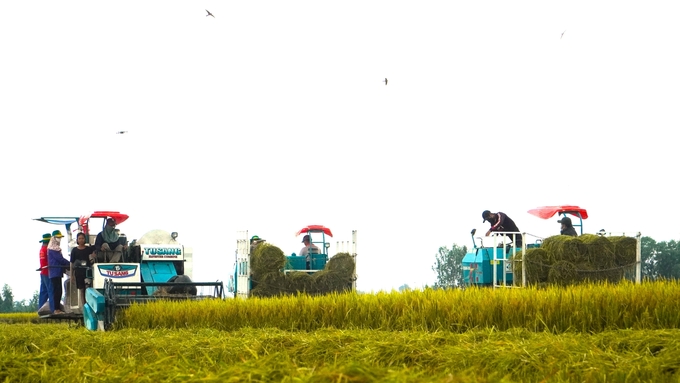
Kien Giang Department of Agriculture and Environment raises a suggestion to grow rice according to business orders to limit consumption risks. Photo: Kim Anh.
To avoid the situation of rice congestion, Le Huu Toan, Director of Kien Giang Department of Agriculture and Environment, proposed a solution. “Localities should shift the crop season to suit the farming conditions of the people and the consumption capacity of businesses. In the past two years, Kien Giang farmers have shifted the crop season by 15 - 20 days. Thus, farmers and businesses can breathe easier,” he said.
Sharing the same view, Le Thanh Tung, Vice President of the Vietnam Rice Industry Association (VIETRISA), emphasized that farmers must reduce production costs in the long run to increase profits. “Mekong Delta provinces should manage production well and implement cost-reducing farming programs to avoid the impact of drought, salinity and early season rains, helping farmers sell rice early at better prices.”
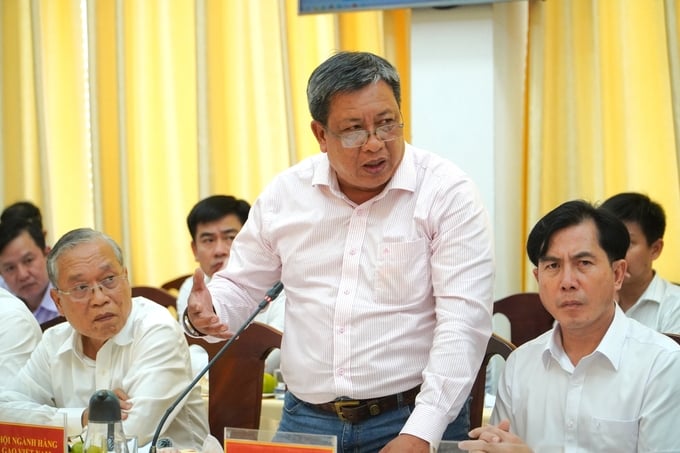
Le Thanh Tung, Vice President of VIETRISA, offers solutions to adjust the rice crop season. Photo: Kim Anh.
According to Pham Thai Binh, Chairman of the Board of Directors of Trung An High-Tech Agriculture Joint Stock Company, rice production still does not maintain a firm chain, hence the "repeatedly" struggles during the winter-spring rice harvest.
To avoid the situation where rice prices sometimes go up and down unexpectedly, it is necessary to expand the Scheme of 1 million ha of high-quality rice instead of opening more pilot programs, thereby creating a legal basis to build a tight connection between farmers, cooperatives and enterprises.
Vice Chairman of An Giang People's Committee Ngo Cong Thuc proposed that the Ministry of Agriculture and Environment advise the Government to build a rice brand to reduce emissions for rice growing areas under the Scheme of 1 million ha of high-quality rice to increase competitiveness and attract joint businesses.
Nguyen Ngoc He, Vice Chairman of Can Tho City People's Committee, requested the Ministry of Agriculture and Environment to speed up the implementation of the Scheme of 1 million ha of high-quality rice as this is a closely linked model that guarantees stable output.
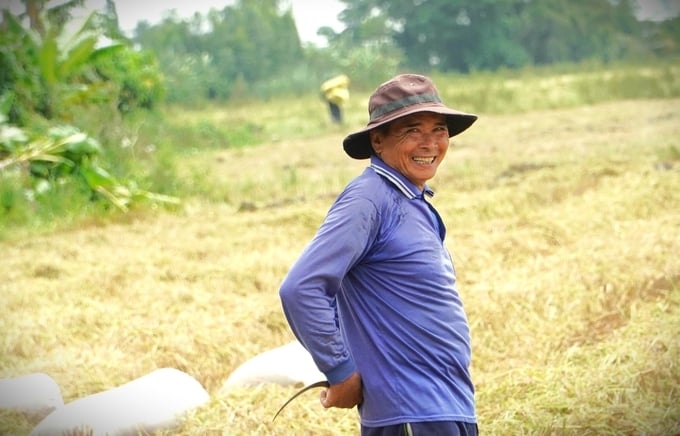
Farmers find joy in a good harvest and good rice prices. Photo: Kim Anh.
In the context of market fluctuations and climate change strongly affecting rice production and consumption, Dr. Bui Ba Bong, Chairman of the Vietnam Rice Industry Association (VIETRISA), said, “The immediate solution and long-term strategy for the Vietnamese rice industry is to develop comprehensively in the direction of transparency, responsibility and sustainability, starting from input supply and agroproduction practices to processing and distribution.
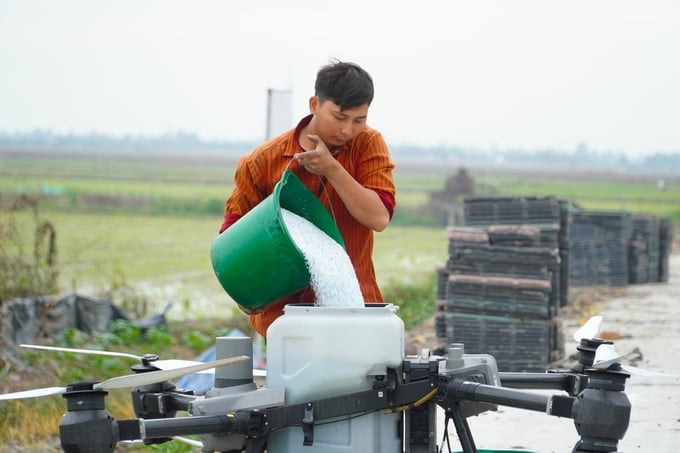
Applying synchronous mechanization in rice cultivation is one of the sustainable solutions, helping farmers reduce costs. Photo: Kim Anh.
Dr. Cao Duc Phat, Chairman of the Board of Directors of the International Rice Research Institute (IRRI) proposed a number of key solutions to improve farming techniques:
Firstly, select and popularize rice varieties with high yield, high quality, and good resistance to factors such as drought, flooding, salinity, and pests;
Secondly, popularize sustainable rice cultivation technical packages. For example, in the Mekong Delta, the "1 must, 5 decreases" technique is currently on the rise, allowing a 30% reduction in input materials while still increasing productivity by 10 - 20% and profits by 20-40%, and reducing greenhouse gas emissions by 20 - 50%;
Thirdly, apply mechanized means of land preparation, sowing, and harvesting; develop irrigation, and processing technology; provide credit; implement competitive market policies; and implement the policy of granting stable and long-term land use rights to farmers.
“Only when all parties join hands can the problem of sustainable development of the rice industry be truly solved. The future of the industry lies not only in productivity but also in added value, transparency and sustainability,” said Dr. Cao Duc Phat.
Translated by Samuel Pham

(VAN) After the institutional merger, Da Nang possesses significant forest-carbon reserves and is proactively engaging in the carbon market, creating a new revenue stream.

(VAN) An Giang strengthens communication against IUU fishing, increases inspections and sanctions, and is determined to remove the EC’s “yellow card” while developing a sustainable fisheries sector.

(VAN) As green transition becomes a global trajectory, Viet Nam’s biggest challenge is not only technology and models, but how to ensure that capital flows reach the right beneficiaries.

(VAN) The Ministry of Agriculture and Environment must spearhead the construction of green governance, spanning decision-making processes and investment standards to policy evaluation mechanisms.

(VAN) The Agriculture and Environment sector of Khanh Hoa has achieved numerous milestones over the past 80 years, contributing significantly to the goal of establishing the province as a centrally governed city by 2030.

(VAN) Viet Nam is entering the pivotal period of 2025-2030, moving toward the formulation of the Remote Sensing Law, which will establish a legal foundation for the development of national digital data.

(VAN) The agricultural sector is finalizing the strategic framework for emission reduction, setting the goal of sharply cutting methane and 403.7 million tons of CO2 equivalent and moving toward Net Zero by 2050.